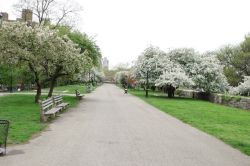Riverside Park
The Daily Plant : Friday, April 9, 2004
REDISCOVERING A GEM OF LANDSCAPE DESIGN, THE MULTI-STEMMED CRABAPPLE TREE

More than 60 years ago, the spreading, low-branched crabapple tree was a favorite among New York City landscape architects. The multi-stemmed crabapple later fell out of fashion, and old specimens began to die out. Parks & Recreation is bringing the sweet-smelling crabapple tree back to New York City landscapes. This past season, Parks & Recreation planted 100 multi-stemmed crabapples, specially imported from a nursery in Illinois, and this spring, Parks & Recreation will plant 50 more.
Crabapple trees have a long and colorful history. Unlike the heavy, succulent apples that have become integral to American cuisine, the crabapple fruit is less than two inches in diameter and will pucker the mouth with its sourness. There is a dizzying array of crabapple and apple tree species, but all domesticated apples are believed to derive from a wild apple found in the mountainous terrain of what is now Kazakhstan. The Silk Road ran through these mountains and introduced Western Europe to products of the Orient, including the apple. The modern traveler of the Silk Road will find the path overgrown with forests of apple trees.
Early American settlers continued the westward trajectory of the apple tree, carrying seeds and seedlings to the New World. The European arrivals were eager to have Old World comforts. With the apple, settlers could cultivate their land with familiar trees, grow apples for traditional dishes, and perhaps most importantly, brew cider (the alcoholic kind). By the mid 1600s, there were over 60 documented varieties of domesticated apples, and probably thousands more in the wild. John Chapman, the legendary Johnny Appleseed, is responsible for creating many of the orchards in the United States. During the late eighteenth and early nineteenth centuries, Chapman capitalized on the popularity of cider and made his fortune traveling West from Massachusetts to Ohio, stopping at frontier posts to plant orchards and sell trees to settlers.
The rise of the temperance movement and the increasing popularity of other fruits and liquors led to a decline in the planting of new orchards. Apple trees only became a high commodity again in the twentieth century, when landscape architects recognized the beauty of the crabapple and began using it as an adornment in their landscape designs.
In the first decades of the twentieth century, landscape architects planted crabapple trees across the country, including in New York City’s parks. In 1935, the Federal Works Progress Administration (WPA) sponsored the creation of new parks, playgrounds, and the site for the 1939-1940 New York World’s Fair in Flushing Meadows. Ornamental crabapples were often used in these projects, many of which were designed by Robert Moses’s consulting landscape architect, Gilmore Clark. Riverside Park and Central Park’s Conservatory Garden still house some of the most glorious stands of crabapple trees.
Although the crabapple is one of the most long-lived ornamental trees, many of the crabapples planted in the early years of the twentieth century have succumbed to old age and disease. The loveliest hybrids of crabapples are often the most prone to fireblight, cedar apple rust, apple scab, mildew, and leaf spot. The International Ornamental Crabapple Society has been rating crabapples for their susceptibility to disease as part of their National Crabapple Evaluation Program, so that new orchards of crabapples will last longer than their predecessors. Meanwhile, Parks & Recreation has begun propagating crabapple whips in the Arthur Ross Nursery in Van Cortlandt Park, and is searching for a grant to help fund the return of the crabapple.
Under the leadership of Commissioner Benepe, Fiona Watt, Parks & Recreation Chief of Forestry and Horticulture, has been the powerhouse behind the effort to bring the multi-stemmed crabapple back to New York City. "The crabapple groves of Riverside Park and the allée of the Conservatory Gardens in Central Park are astoundingly beautiful in all seasons of the year," she said. "To stand amongst the fallen blossoms is almost a religious experience."
Written by Dana Rubinstein
QUOTATION FOR THE DAY
Cling, swing,
Spring, sing,
Swing up into the apple tree.
T.S. Eliot
(1888–1965)
Check out your park's Vital Signs
Clean & Safe
Green & Resilient
Empowered & Engaged Users
Share your feedback or learn more about how this park is part of a
Vital Park System

Know Before You Go
Related inquiries may be sent to boatbasin@parks.nyc.gov
Related inquiries may be sent to boatbasin@parks.nyc.gov


